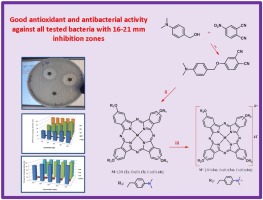当前位置:
X-MOL 学术
›
Synth. Met.
›
论文详情
Our official English website, www.x-mol.net, welcomes your feedback! (Note: you will need to create a separate account there.)
Comparison of novel tetra-substituted phthalocyanines with their quaternized derivatives: Antioxidant and antibacterial properties
Synthetic Metals ( IF 4.4 ) Pub Date : 2020-02-01 , DOI: 10.1016/j.synthmet.2019.116288 Armağan Günsel , Ahmet T. Bilgiçli , Canberk Kandemir , Rüveyda Sancak , Gulnur Arabaci , M. Nilüfer Yarasir
Synthetic Metals ( IF 4.4 ) Pub Date : 2020-02-01 , DOI: 10.1016/j.synthmet.2019.116288 Armağan Günsel , Ahmet T. Bilgiçli , Canberk Kandemir , Rüveyda Sancak , Gulnur Arabaci , M. Nilüfer Yarasir

|
Abstract In this study, we describe the synthesis and characterization of 2(3), 9(10), 16(17), 23(24)-tetrakis (4-(dimethylamino)benzyloxy) metal-free (2), zinc (II) (3) and cobalt (II) (4) phthalocyanines and comparison of their antioxidant and antibacterial properties with their quaternized derivatives (2a-4a). The antioxidant activities of the all synthesized compounds were emphasized by using three different methods. The results of the experiments showed that the highest DPPH (1,1-diphenyl-2-picrylhydrazyl) activity was determined to be 91.95 % for compound (2). In comparison, phthalocyanines containing 4-(dimethylamino)benzyloxy groups had similar DPPH activity with their quaternized derivatives. In the ferrous ion chelating activity and reducing power assays, compound (2a) showed the highest activity with 97.70 % for chelating activity and 2.34 mg/L for reducing power assay. In comparison, the quaternized derivatives (2a-4a) had much better chelating activity than the non-quaternized ones. However, they had less reducing power than the non-quaternized ones (2–4). In addition, the results of the antibacterial activity determination studies showed that only (2a) and (4a) compounds had good antibacterial activity against E.coli, B. Subtilis (ATCC 6051), B. Subtilis (ATCC 6633), B. Cereus (SBT8) and S. aureus bacteria with 16−21 mm inhibition zones. The positive results revealed that the quaternized derivatives (2a-4a) have good antioxidant and promising antibacterial properties.
中文翻译:

新型四取代酞菁与其季铵化衍生物的比较:抗氧化和抗菌性能
摘要 在本研究中,我们描述了 2(3)、9(10)、16(17)、23(24)-四(4-(二甲氨基)苄氧基)无金属 (2)、锌 ( II) (3) 和钴 (II) (4) 酞菁及其与季铵化衍生物 (2a-4a) 的抗氧化和抗菌性能的比较。通过使用三种不同的方法来强调所有合成化合物的抗氧化活性。实验结果表明,化合物(2)的最高DPPH(1,1-二苯基-2-苦基肼)活性测定为91.95%。相比之下,含有 4-(二甲氨基)苄氧基的酞菁与其季铵化衍生物具有相似的 DPPH 活性。在亚铁离子螯合活性和还原能力测定中,化合物 (2a) 显示出最高的活性,螯合活性为 97.70%,而化合物 2. 34 mg/L 用于还原能力测定。相比之下,季铵化衍生物 (2a-4a) 比非季铵化衍生物具有更好的螯合活性。然而,它们的还原能力低于非季铵化的 (2-4)。此外,抗菌活性测定研究结果表明,只有(2a)和(4a)化合物对大肠杆菌、枯草芽孢杆菌(ATCC 6051)、枯草芽孢杆菌(ATCC 6633)、蜡状芽孢杆菌具有良好的抗菌活性(SBT8) 和具有 16-21 mm 抑菌圈的金黄色葡萄球菌。阳性结果表明季铵化衍生物 (2a-4a) 具有良好的抗氧化和抗菌性能。它们的还原能力低于非季铵化的 (2-4)。此外,抗菌活性测定研究结果表明,只有(2a)和(4a)化合物对大肠杆菌、枯草芽孢杆菌(ATCC 6051)、枯草芽孢杆菌(ATCC 6633)、蜡状芽孢杆菌具有良好的抗菌活性(SBT8) 和具有 16-21 mm 抑菌圈的金黄色葡萄球菌。阳性结果表明季铵化衍生物 (2a-4a) 具有良好的抗氧化和抗菌性能。它们的还原能力低于非季铵化的 (2-4)。此外,抗菌活性测定研究结果表明,只有(2a)和(4a)化合物对大肠杆菌、枯草芽孢杆菌(ATCC 6051)、枯草芽孢杆菌(ATCC 6633)、蜡状芽孢杆菌具有良好的抗菌活性(SBT8) 和具有 16-21 mm 抑菌圈的金黄色葡萄球菌。阳性结果表明季铵化衍生物 (2a-4a) 具有良好的抗氧化和抗菌性能。
更新日期:2020-02-01
中文翻译:

新型四取代酞菁与其季铵化衍生物的比较:抗氧化和抗菌性能
摘要 在本研究中,我们描述了 2(3)、9(10)、16(17)、23(24)-四(4-(二甲氨基)苄氧基)无金属 (2)、锌 ( II) (3) 和钴 (II) (4) 酞菁及其与季铵化衍生物 (2a-4a) 的抗氧化和抗菌性能的比较。通过使用三种不同的方法来强调所有合成化合物的抗氧化活性。实验结果表明,化合物(2)的最高DPPH(1,1-二苯基-2-苦基肼)活性测定为91.95%。相比之下,含有 4-(二甲氨基)苄氧基的酞菁与其季铵化衍生物具有相似的 DPPH 活性。在亚铁离子螯合活性和还原能力测定中,化合物 (2a) 显示出最高的活性,螯合活性为 97.70%,而化合物 2. 34 mg/L 用于还原能力测定。相比之下,季铵化衍生物 (2a-4a) 比非季铵化衍生物具有更好的螯合活性。然而,它们的还原能力低于非季铵化的 (2-4)。此外,抗菌活性测定研究结果表明,只有(2a)和(4a)化合物对大肠杆菌、枯草芽孢杆菌(ATCC 6051)、枯草芽孢杆菌(ATCC 6633)、蜡状芽孢杆菌具有良好的抗菌活性(SBT8) 和具有 16-21 mm 抑菌圈的金黄色葡萄球菌。阳性结果表明季铵化衍生物 (2a-4a) 具有良好的抗氧化和抗菌性能。它们的还原能力低于非季铵化的 (2-4)。此外,抗菌活性测定研究结果表明,只有(2a)和(4a)化合物对大肠杆菌、枯草芽孢杆菌(ATCC 6051)、枯草芽孢杆菌(ATCC 6633)、蜡状芽孢杆菌具有良好的抗菌活性(SBT8) 和具有 16-21 mm 抑菌圈的金黄色葡萄球菌。阳性结果表明季铵化衍生物 (2a-4a) 具有良好的抗氧化和抗菌性能。它们的还原能力低于非季铵化的 (2-4)。此外,抗菌活性测定研究结果表明,只有(2a)和(4a)化合物对大肠杆菌、枯草芽孢杆菌(ATCC 6051)、枯草芽孢杆菌(ATCC 6633)、蜡状芽孢杆菌具有良好的抗菌活性(SBT8) 和具有 16-21 mm 抑菌圈的金黄色葡萄球菌。阳性结果表明季铵化衍生物 (2a-4a) 具有良好的抗氧化和抗菌性能。



























 京公网安备 11010802027423号
京公网安备 11010802027423号